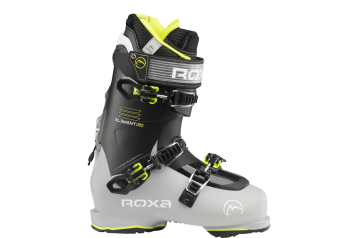The new Roxa Element 120 I.R. impressed our test team with its solid-as-a-rock fore-aft stability and lightning quick transitions from turn to turn. They said that it over-performed in stiffness, based on expectations for a 120-level flex feel (it's stiffer, they say) and it trended toward the narrow fit side of the 99mm fence.
For the right skier these are bonuses--like the long legged, more aggressive testers on our team who liked how well the Element 120's cuff held up to hard flexing, and the testers who always lament the modern medium width boot's too comfy approach to heel hold. These testers thought the Element 120 was right up their alley. Testers with shorter legs and those looking for a little more give for the shin recommended that the cuff be put into its soft flexing mode (a nice feature, they agreed) and consider a full liner molding session to allow the top of the spiral liner to flare and relax as a way to get a less tall, less rigid feel against the leg.
Every tester that spent time in the Element in its stock form, then took the time to heat mold the liner either in a convection oven or on a hot stacks for subsequent re-tests came back with improved results, both for anatomical fit (duh, right?) but also for skiing performance. Testers thought that the resulting better shape match for the foot and the leg, post molding, did a good job of connecting the feel of the upper and lower boot for more dynamic, supple movements which bumped up the Element 120's all-mountain versatility.
Testers liked the walk mode's function, and could see how this was a useful features for skiers who might be sessioning a jump or schlogging back up for another half-pipe run. And there's always a variety of parking lot parties that need attending. There is a 130-flex version of the Element, which would be a stout beast, our test team reckoned. They also surmised that the 100-flex Element in the stiff mode might be a great sleeper, big-bang-for-the-buck option for those seeking a smoking deal.







Kudos
Caveats